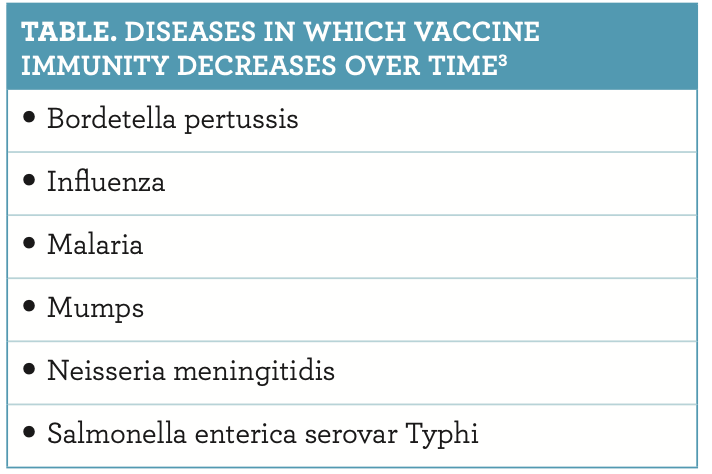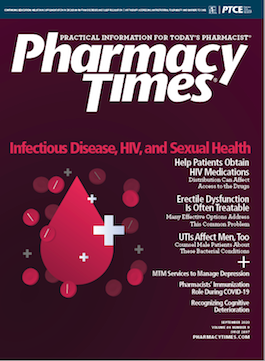Publication
Article
Pharmacy Times
Waning Immunity Creates Risk
Author(s):
Streamlining the Adjuvant Testing Process Could Be Key to Accelerating the Development of Long-Lasting Vaccines
Vaccines have made a significant impact on public health by controlling infectious diseases across the world.
Although some vaccines create long-term immunity, with others the immunity wanes over time, creating the risk of infectious diseases spreading. Immunity in the absence of vaccination is maintained through frequent exposure to infection throughout one’s lifetime, which boosts waning immunity.1 In this postvaccine world, however, the prevalence of infection declines, resulting in less exposure and boosting. This can potentially lead to epidemic cycles where infection rates fall following vaccination and then rise as immunity wanes.2 Each vaccine faces issues that are complex and varied. The table3 lists diseases for which current vaccines have demonstrated waning immunity.3
PERTUSSIS
Pertussis vaccines come in 2 forms: acellular vac- cines (ACV) and whole-cell vaccines (WCV). DTP (diphtheria, tetanus, pertussis) is a WCV, whereas DTaP is acellular. Patients receiving the DTaP vaccine experienced fewer adverse reactions, such as fever and seizures, making it the preferred form.4 However, pertussis antibody (Ab) titers wane substantially in children immunized with ACVs. Pharmacists handle this by providing booster Tdap vaccines, but boosters provide immunity that wanes very rapidly in patients primed with ACVs.5
Investigators think that the mechanism by which ACV-vaccinated individuals lose protection has to do with failure to induce TH1 cells, complement-mediated killing, and/or the recruitment of phagocytic cells. When compared with WCVs, ACVs had higher rates of Th2 response but lower rates of TH1 and TH17 responses.6 Evidence has shown that children primed with WCV had higher B cell memory responses upon immunization and higher CD4+ T-cell counts after receiving a booster compared with ACVs. Efforts are underway to improve the functionality of ACVs with the use of adjuvants that are designed to enhance the immune response and increase its duration.

MUMPS
Mumps cases have declined to only a few hundred cases from more than 200,000 after the introduction of a vaccine in 1967. However, many countries have seen outbreaks of mumps, including the United States. The figure7 shows US outbreaks by year. Recent ones have occurred on college and university campuses among young adults who had been vaccinated during childhood. Investigators think that waning immunity caused these outbreaks, as study results have shown that the odds of developing mumps increased from 10% to 27% with each year post vaccination.8
Mumps is given as a 2-dose series and has been studied as a 3-dose series. When adolescents received a third dose, virus-neutralizing antibodies significantly increased, but dropped to baseline within a year.9 Data have shown that the virus-specific memory B cells targeted for mumps and the avidity of antibodies for the mumps virus are far lower compared with the measles and rubella portion of the MMR vaccine.10 Stimulating greater numbers of memory B cells and increasing the antibody avidity to mumps virus antigens could be a step forward to increasing long-term immunity.
INFLUENZA
Influenza vaccines contain proteins of the 2 main A and B virus strains. Patients must receive the vaccines each year because of genetic drift through mutation. Even controlling for drift, protective immunity wanes within 6 to 18 months, depending on age and other population factors. Investigators noted that plasma blasts in the blood were not responsible for long-term Ab responses, although plasma cells that reside in the bone marrow could secrete Abs without antigenic stimulation. Studies are underway to examine how plasma cell numbers change in the bone marrow post vaccination. Investigators could use such evidence to design vaccines to boost bone marrow plasma cells’ permanence. In another study, the authors analyzed the role of CD4 T memory cells post vaccination and found that populating hosts with these cells enhanced the germinal center and Ab response to influenza virus infections.11
Novel strategies are required to measure and predict the potential for waning immunity and to help elicit longer lasting immunity. Members of the Precision Vaccines Program are studying and modeling vaccine responses in vulnerable populations to determine how age, demographics, the environment, and gender affect immune response.12 This could help investigators identify lead compounds and adjuvants that have a higher likelihood of success, saving on the costs of repeated failed attempts.

CONCLUSION
Historically, adjuvant testing has largely been trial and error. Streamlining this process could be crucial in speeding up the development of vaccines that are effective, long-lasting, and safe. Because a single adjuvant agent is unlikely to elicit a response in all populations, investigators are developing ones to enhance immune response across all or in targeted populations. Although the problems confronting each vaccine are unique, data gathered through these endeavors will pave the way for new vaccine technologies.®
References
- Whittle HC, Aaby P, Samb B, Jensen H, Bennett J, Simondon F. Effect of subclinical infection on maintaining immunity against measles in vaccinated children in West Africa. Lancet. 1999;353(9147):98-102. doi:10.1016/s0140-6736(98)02364-2
- Heffernan JM, Keeling MJ. Implications of vaccination and waning immunity. Proc Biol Sci. 2009;276(1664):2071-2080. doi:10.1098/rspb.2009.0057
- Gu XX, Plotkin SA, Edwards KM, et al. Waning immunity and microbial vaccines—workshop of the National Institute of Allergy and Infectious Diseases. Clin Vaccine Immunol. 2017;24(7):e00034-17. doi:10.1128/cvi.00034-17
- Pertussis vaccination: use of acellular pertussis vaccines among infants and young children. Recommendations of the Advisory Committee on Immunization Practices (ACIP). MMWR Recomm Rep. 1997;46(RR-7):1-25. doi:10.1037/e547522006-001
- Bancroft T, Dillon MBC, Antunes RDS, et al. Th1 versus Th2 T cell polarization by whole-cell and acellular childhood pertussis vaccines persists upon re-immunization in adolescence and adulthood. Cell Immunol. 2016;304-305:35-43. doi:10.1016/j.cellimm.2016.05.002
- Edwards KM, Decker MD, Bradley RB, Taylor JC, Hager CC. Booster response to acellular pertussis vaccine in children primed with acellular or whole cell vaccines. Pediatr Infect Dis J. 1991;10(4):315-318. doi:10.1097/00006454-199104000-00010
- Mumps cases and outbreaks. Centers for Disease Control and Prevention. Updated February 11, 2020. Accessed July 17, 2020. https://www.cdc.gov/mumps/outbreaks.html
- Cortese MM, Jordan HT, Curns AT, et al. Mumps vaccine performance among university students during a mumps outbreak. Clin Infect Dis. 2008;46(8):1172-1180. doi:10.1086/529141
- Fiebelkorn AP, Coleman LA, Belongia EA, et al. Mumps antibody response in young adults after a third dose of measles-mumps-rubella vaccine. Open Forum Infect Dis. 2014;1(3):ofu094. doi:10.1093/ofid/ofu094
- Kontio M, Jokinen S, Paunio M, Peltola H, Davidkin I. Waning antibody levels and avidity: implications for MMR vaccine-induced protection. J Infect Dis. 2012;206(10):1542-1548. doi:10.1093/infdis/jis568
- Sant AJ, Dipiazza AT, Nayak JL, Rattan A, Richards KA. CD4 T cells in protection from influenza virus: Viral antigen specificity and functional potential. Immunol Rev. 2018;284(1):91-105. doi:10.1111/imr.12662
- Haren SDV, Dowling DJ, Foppen W, et al. Age-Specific Adjuvant Synergy: Dual TLR7/8 and Mincle Activation of Human Newborn Dendritic Cells Enables Th1 Polarization. J Immunol. 2016;197(11):4413-4424. doi:10.4049/jimmunol.1600282







